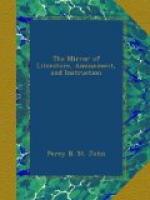Many of the Orioles’ nests are also deserving notice. The black and yellow Oriole, inhabiting South America, has a pendent nest, shaped like an alembic; it is affixed to the extreme branches of trees; sometimes, it is said, so many as four hundred nests are found hanging on the same tree.
The Philippine and Pensile Grosbeak make also very curious nests.
In concluding this account of the nests of birds, I may notice here the nest of the Hirundo esculenta, or Esculent Swallow, an inhabitant of China and the Islands of the Indian Ocean. The nest consists of a gelatinous substance, in shape resembling an apple cut down the middle. The nests are found in great numbers together, and are by the luxurious Asiatics made into broths, and otherwise cooked, and are esteemed one of the greatest dainties of the table; they are also occasionally used for glue.—Jennings’s Ornithologia.
[1] We are pleased therefore
to commence our Supplementary Sheet
with
such a volume as the present, which we have reserved
for
this
purpose. The feelings which it must engender in
the reader
will
be doubly grateful in these troublous times of strong
political
excitement: they enjoin “peace on earth,
and goodwill
towards
men.” the Divine antidote to the storms of conflicting
interests
and passions, and the balm which heals the thorny
wounds
of the world, that cross every path and tear the finest
sympathies
of our nature. It adds, moreover, a pleasant variety
to
the contents of our sheet, and alternates with the
vicissitudes
of enterprise, in the progress of infant liberty
in
the New World, as in the Memoirs of the patriot Miller;—the
daring
and recklessness of crime, as in the vivid sketch of
First
and Last;—the picturesque country and
ceremonies of
Arabia
and its religious people, as drawn by Burckhardt;—and
the
architectural embellishment of the Metropolis, as shown
in
Britton’s
Picture of London.
[2] In the MIRROR, dated March
1, 1828, we noticed “Gilbert White’s
Natural
History of Selborne, is one of the most delightful
household
books in our language, and we are surprised at the
rarity
of such works.” The publication of the Journal
of a
Naturalist,
early in March, 1829, is “a coincidence.”
[3] Philosophers and wits
have written on this subject. Sir Thomas
Brown,
who wrote a book of Vulgar Errors, remarks with
great
seriousness
that the man “who could eradicate this error
from the
minds
of the people, might prevent the fearful passions of
the
heart,
and many cold sweats taking place in grandmothers and
nurses”—Swift
lets fly the shafts of satire in these lines.—




